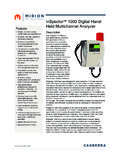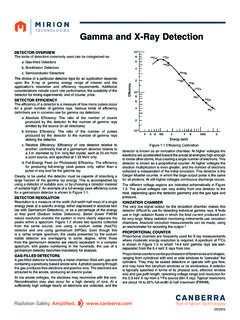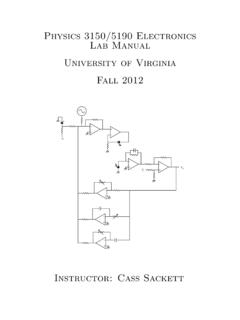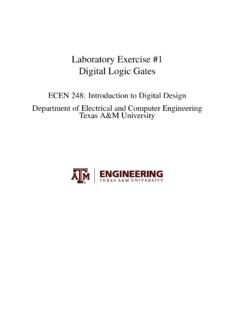Transcription of Laboratory Manual: Nuclear Science Experiments …
1 Manual: Nuclear Science Experiments with digital ElectronicsNUCLEAR MEASUREMENT SOLUTIONS FOR SAFETY, SECURITY & THE ENVIRONMENTN uclear Science Experiments with digital ElectronicsLaboratory Manual2 ..3 Equipment Matrix ..6 experiment 1 Gamma-Ray Detection with Scintillator Detectors ..7 experiment 2 Counting Statistics and Error Prediction ..13 experiment 3 Gamma-Ray Absorption in Matter (Basic) ..17 experiment 4 Compton Scattering ..23 experiment 5 Half-Life Measurement ..27 Table of ContentsExperiment 6 Signal Processing with digital Signal Electronics ..31 experiment 7 High-Resolution Gamma-Ray Spectroscopy with HPGe detectors ..37 experiment 8 Gamma-Ray Efficiency Calibration ..43 experiment 9 Gamma-Ray Coincidence Counting Techniques ..49 experiment 10 Positron Annihilation.
2 57 experiment 11 Mathematical Efficiency Calibration ..63 experiment 12 True Coincidence Summing ..69 Glossary of Terms and Acronyms ..74 References and Further Reading ..75 List of Contributors:James Cocks, Ph. D. in Nuclear Physics, University of Liverpool, 1996. Gabriela Ilie, in Nuclear Physics, University of K ln, 2008. Henrik J derstr m, in Nuclear Physics, Uppsala Universitet, Mueller, in Nuclear Physics, University of Tennessee, Oginni, in Nuclear Physics, Ohio University, Patil, in Nuclear Engineering, Missouri University of Science and Technology, Venkataraman, in Nuclear Engineering, University of Michigan, 1995. Professor Paul Nolan, University of LiverpoolDr Andrew Boston, University of LiverpoolNuclear Science Experiments with digital ElectronicsLaboratory ManualNuclear measurement solutions for safety, security & the environment.
3 3 ForewordThe purpose of this Laboratory manual is to describe Nuclear physics Experiments utilizing the latest counting electronics that are in broad use in today s industry. The goal is to deliver highly productive training in the fundamentals of Nuclear physics while providing the student with hands-on experience that is of vocational relevance. The Experiments are built around the Osprey and Lynx digital Signal Analyzers. The versatility of these instruments enables the performance of fundamental Experiments in high-and low-medium resolution gamma spectroscopy and neutron counting. Their advanced features allow for higher-level Experiments , such as coincidence and anti-coincidence, with both hardware gating and event-by-event data. The Osprey and Lynx are easy to use and feature highly-stable digital electronics, thereby providing the optimum solution for Laboratory instruction.
4 The devices are controlled with ProSpect Gamma Spectroscopy Software which includes a flexible security feature to ensure that the student is only presented with the functions required for the class. This increases the productivity of the format of each experiment is consistent across the manual , beginning with the goal and the equipment required. Each description includes the required steps together with the format of the data entry and the results. It is envisaged that, in some cases, the instructor may wish to produce his or her own Laboratory script with this as a starting point. A relatively modest investment yields a flexible equipment package that can serve undergraduate and post-graduate university training in addition to in-house training for industrial users.
5 The Experiments described in this manual are performed using two packages available for purchase:1 LABKIT-Basic: for Experiments 1-52 LABKIT-Advanced : for Experiments 6-12 (also requires LABKIT-Basic)Contact CANBERRA for more Science Experiments with digital ElectronicsLaboratory ManualFor each, the immediate container for the radioactive material will bear a label identifying the radioisotope, the quantity of activity, and the warning radioactive material . Solid sealed sources are typically easier to use and account for than sealed sources. Because they usually contain radioactive isotopes with long half-lives, they can be reused year after year. Additionally, one is not faced with possible spills and decontamination when using solid sealed sources. Sealed sources of low activity, such as a gamma source of 1 Ci (or 37 kBq) or less, can be handled directly without significant risk, although it is good practice to utilize tongs.
6 More active sealed gamma sources, such as 10 Ci (or 370 kBq) or more, should only be handled with tongs. Liquid sources or unsealed sources are required for certain Experiments and pose a greater risk for contamination and ingestion. Thin rubber or disposable gloves should always be worn when handling liquid sources, and it is also a good practice to work over a tray lined with absorbent paper when using these with Radioactive Sources Several types of radioactive sources are required to perform the Experiments described in this Laboratory manual . These include both sealed and unsealed sources with a range of activity. When working with radioactive sources, utilize the three basic principles of ALARA, either individually or in combination:ALARA As Low As Reasonably AchievableTime: The simplest way to reduce exposure is to keep the time spent around a radioactive source to a minimum.
7 If time is cut in half, so is the exposure, with all the other factors remaining : Distance is another effective means to reduce radiation exposure. A formula known as the inverse square law relates the exposure rate to distance. Doubling the distance from a radioactive source reduces the exposure to one-fourth its original value. If the distance is tripled, the exposure is reduced by a factor of : Shielding is any material used to reduce the radiation reaching the user from a radioactive source. While a single sheet of paper may stop some types of radiation such as alpha particles, other radiation such as neutrons and photons require much more shielding. Dense materials, such as lead or steel, are used to shield photons. Materials containing large amounts of hydrogen, such as polyethylene, are used to shield speaking, radioactive sources prepared for educational use are of two types: 1 Solid sources in which the radioactive material is deposited in a plastic disk and sealed inside with a durable epoxy.
8 2 Unsealed sources packaged in small vials, supplied in solution form. Nuclear measurement solutions for safety, security & the environment. 52 NuclearNmcsNcantocemicsfya,mf& luStorage Because of the low levels of activity used in student sources, storing these radioactive materials is a relatively simple matter. Solid sealed sources can be safely stored in the original plastic containers in which they are received. Liquid sources are normally received in plastic vials surrounded by packing material. These containers are sufficient for the safe storage of radioisotopes. It is recommended that all radioactive materials be kept in one specific and secured place, such as in the instructor s preparation room and in a locked cabinet. This cabinet can be lined with lead sheets or bricks if additional shielding is necessary.
9 Any storage cabinet, locked drawer, or lead isotope container should be properly labeled with approved radioactive material warning labels. Conducting a frequent inventory of sources is also a good procedure to very fact that radioactive materials decay with time can be a most effective method of disposal. Dilution and burial are two other often-used methods. Solid radioactive waste which may accumulate in the Laboratory includes materials such as empty radioisotope vials, disposable gloves, syringes, and absorbent paper. These often result in exempt quantities of radioisotopes, which can generally be safely disposed of with the routine Laboratory trash. It is normal practice in radioisotope laboratories to pour all liquid waste into a single wide-mouth bottle labeled radioactive liquid waste.
10 This waste can be held by the teacher for as long as possible in order to allow for normal decay. For both solid and liquid radioactive waste, consult with your local regulatory authority regarding proper and safe disposal in the development of your protocols. Never wear the same rubber gloves while operating your counting instrument, as any contamination on the glove could be transferred to the instrument. No food or drink is ever to be permitted in a radioactive Laboratory . Another good habit to acquire is never allowing the hands to touch any other part of the body, or another individual, while working with liquid word of6 Science Experiments with digital ElectronicsLaboratory ManualExperimentModelDescription12345678 9101112 Osprey-ProSpectProSpect Gamma Spectroscopy SoftwareBBBBBBBBBBBBO sprey digital Tube BaseBBBBB BB 802-2x2 NaI Detector 2" x 2"BBBBBB BB LABKIT-TableTeaching Laboratory Scattering Table Assembly (Includes Table, NaI Detector Shielding, Source Collimation, and Scattering Pillar)B BB BB B B BB LABKIT-ABST eaching Laboratory Absorber Set B B BLABKIT-SR-Cs137137Cs source compatible with Scattering Table Assembly B Radioisotopes (provided separately)














